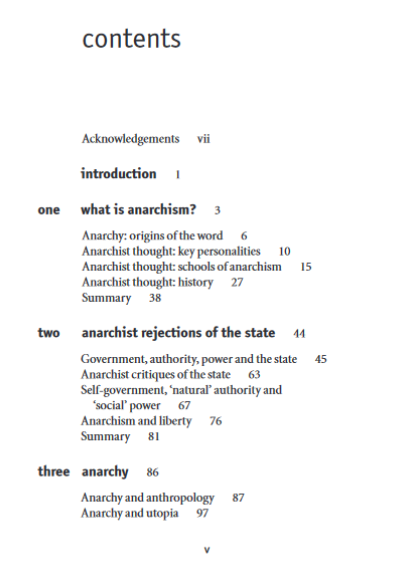Author(s)
Contents


“This book falls into four chapters, each organized around a particular theme: (i) the ideology of anarchism; (ii) anarchist conceptions of the state; (iii) principles of anarchist organization (ideas of anarchy); and (iv) strategies for change.
The first chapter begins by introducing the terms anarchism, anarchist and anarchy and then discusses the problems anarchists have encountered with popular conceptions of anarchy. The main body of the chapter looks at three different approaches to anarchism.ances, active in the latter decades of nineteenth-century Europe. The aim of this chapter is to suggest that anarchism can be defined as an ideology by the adherence of anarchists to a core belief namely, the rejection of the state.
The second chapter considers some of the ways in which anarchists have theorized the state and the grounds on which they have called for its abolition. This chapter also reviews anarchist theories of liberty, in an effort to show why anarchists believe anarchy is superior to the state, and to illustrate the broad difference between anarchist communitarians and “libertarians”.
The third chapter looks at anarchist ideas of organization and some models of anarchy. It looks first at the ways in which anarchists have understood the relationship between anarchy and statelessness, and the use they have made of anthropology to formulate ideas of anarchy. The second part of the chapter considers anarchist responses to utopianism, identifies decentralized federalism as the principle of anarchist planning and outlines two ‘utopian’ views of this principle. The last part of the chapter considers some experiments in anarchy, both historical and contemporary, highlighting the relationship that some anarchists posit between organization and revolutionary change.
The final chapter examines strategies for change – both revolutionary and evolutionary – and different methods of protest, from symbolic to direct action. The chapter includes [reviews] of the important arguments that anti-globalization protest has raised : the justification of violence.”
Ruth Kinna
Leave a comment below with a valid email adress (it will not be published) to request this book.


 Anarchism : a Beginner's Guide (2005)
Anarchism : a Beginner's Guide (2005)  Kinna, Ruth
Kinna, Ruth